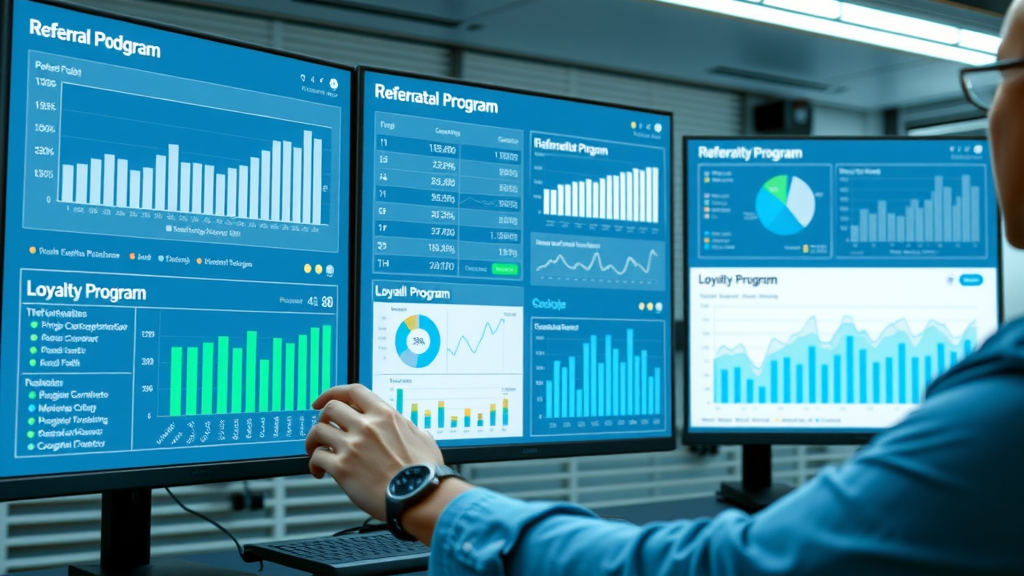Did you know that 65% of new business comes from referrals, yet many small businesses overlook the power of referral and loyalty programs in driving sustainable growth? Small businesses today face fierce competition and the challenge of retaining customers while constantly acquiring new ones. Leveraging referral and loyalty programs offers a proven strategy to build trust, boost sales, and develop lasting relationships with customers.
What You'll Learn
- The fundamental differences between referral and loyalty programs
- How referral and loyalty programs boost customer retention and conversion rates
- Key strategies to design effective referral and loyalty programs
- Expert insights from Keir Anderson, Founder of Digital Red Zone
- Common mistakes to avoid when implementing these programs
- How to measure the success of your referral and loyalty initiatives
Understanding Referral and Loyalty Programs: Definitions and Differences
What is a Referral Program?
Referral programs are marketing strategies designed to encourage existing customers to recommend a business’s products or services to their friends, family, or colleagues. These programs reward customers for bringing new clients, which effectively turns your satisfied customer base into an active sales force. Referrals capitalize on personal trust, which significantly increases the likelihood of converting prospects into paying customers.
According to Keir Anderson, Founder of Digital Red Zone, “Referral and loyalty programs tap into trust and retention. These aren’t just tactics—they’re sustainable growth levers that compound over time.” This highlights how referral programs not only enable short-term gains but also fuel long-lasting growth by leveraging customer relationships.

What is a Loyalty Program?
Loyalty programs are designed to reward existing customers for repeat business and sustained engagement. These programs typically offer points, tiers, discounts, or exclusive rewards in exchange for continued purchases or interactions with the brand. Loyalty programs focus on enhancing customer satisfaction and increasing customer lifetime value by incentivizing ongoing patronage rather than one-time purchases.
They create an emotional and financial bond between the customer and the company, motivating repeat purchases, and nurturing a stable and valuable customer base.
Key Differences Between Referral and Loyalty Programs
While both referral and loyalty programs aim to increase customer engagement and business growth, their approaches differ fundamentally:
- Referral programs focus on acquiring new customers through existing customers’ personal recommendations.
- Loyalty programs focus on retaining and rewarding existing customers for repeat business.
- Referral initiatives leverage trust networks to expand the customer base, whereas loyalty initiatives strengthen ongoing relationships.
- Referral rewards often incentivize advocating the brand, while loyalty rewards incentivize repeat purchasing behavior.
Understanding these distinctions helps small businesses design programs tailored to their unique goals and customer dynamics.
Why Referral and Loyalty Programs Matter for Small Businesses
Impact on Customer Retention and Conversion Rate
Customer retention represents one of the most cost-effective ways to grow a business. Referral and loyalty programs significantly boost retention rates by rewarding customers' engagement and advocacy. A referred customer is typically more likely to convert because they come with a built-in level of trust passed from the referrer.
Moreover, loyalty programs encourage repeat purchases by making customers feel valued and appreciated, thereby directly improving conversion metrics. As Keir Anderson observes, “The last 20 yards of your funnel determine whether you score or stall.” Tailored referral and loyalty programs create that crucial push to convert interest into sales.
Influence on Customer Behavior and Lifetime Value
Referral and loyalty programs shape customer behavior by providing incentives that encourage repeated interactions and endorsements. Customers motivated by rewards tend to increase their spending frequency and the average value of purchases.
Over time, the cumulative effect results in an enhanced Customer Lifetime Value (CLV) , which is essential for sustainable profitability in small businesses. Higher CLV means customers not only bring revenue but also evangelize the brand, creating a virtuous growth cycle.
Building a Loyal Customer Base
Establishing a loyal customer base is fundamental for small businesses aiming to thrive in a competitive landscape. Referral and loyalty programs build emotional connections while offering tangible benefits, thereby creating brand advocates and repeat buyers. Such programs further provide valuable data insights into customer preferences, helping businesses personalize experiences and offers.

Designing Effective Referral and Loyalty Programs
Crafting the Right Offer to Earn Points and Rewards
The foundation of any successful referral and loyalty program is a compelling and carefully crafted offer. It must resonate with your target audience and motivate action. Whether it’s discount coupons, exclusive access, or point accumulation, the offer decides the program’s appeal and effectiveness.
Keir Anderson shares, “We don’t just launch campaigns; we make sure your offer is tight first. The offer is what makes people stop scrolling, take action, and ultimately buy.” This perspective underscores the value of refining your rewards before promoting the program widely to ensure maximum impact.

Referral Marketing Strategies That Work
Referral marketing strategies must lower friction for customers to easily share and recommend. Successful programs often include personalized referral links, social sharing buttons, and instant rewards upon referral verification. Clear communication and simplicity are key to driving participation and maintaining momentum.
Additionally, timing a referral ask appropriately—after a positive customer experience—is critical to increasing the likelihood of referrals. Companies should also ensure they track referral sources accurately to reward advocates properly and maintain trust.
Loyalty Program Types: Tier-Based, Points, and Rewards Programs
Loyalty programs typically fall into three major categories:
- Points Programs: Customers earn points for purchases that can be redeemed for discounts or gifts.
- Tier-Based Programs: Customers unlock higher rewards and perks as they reach spending thresholds.
- Rewards Programs: Direct incentives like cash back, exclusive offers, or early access to products.
Choosing the right structure depends on your customer behavior and business goals. Each type has unique benefits and challenges, but all aim to increase engagement and spend.

Common Mistakes and Misconceptions in Referral and Loyalty Programs
Avoiding Overcomplicated or Ineffective Rewards
An often seen error is designing complex reward systems that confuse or frustrate customers, resulting in disengagement. Simple, transparent rewards with easy-to-understand rules foster better participation.
Keir Anderson advises focusing on clarity and relevance in offers, ensuring customers see real value without cumbersome processes. This reduces drop-off rates and increases the program’s sustainability.

Misunderstanding Customer Motivation
Another misconception is assuming all customers are motivated by the same rewards. Some customers value discounts, while others prefer exclusive experiences or recognition. Understanding your audience’s preferences allows customization that maximizes emotional and financial appeal.
Failing to account for motivation diversity can result in poor engagement and wasted marketing spend.
Measuring Success: Key Metrics for Referral and Loyalty Programs
| Metric | Description | Why It Matters |
|---|---|---|
| Conversion Rate | Percentage of referred or loyal customers who make a purchase | Indicates program effectiveness in driving sales |
| Customer Retention | Rate at which customers continue to buy over time | Measures loyalty and satisfaction |
| Customer Lifetime Value | Total revenue generated by a customer over their relationship | Reflects long-term profitability |
| Referral Rate | Percentage of customers who refer others | Shows program engagement and reach |

Expert Insights and Best Practices from Keir Anderson of Digital Red Zone
"The last 20 yards of your funnel determine whether you score or stall. We help businesses close that gap by focusing on high-impact strategies that convert," says Keir Anderson, Founder of Digital Red Zone.
Integrating Referral and Loyalty Programs for Maximum Impact
Combining referral and loyalty programs can magnify growth by addressing both acquisition and retention simultaneously. By incentivizing customers to not only return but also actively promote your business, small enterprises can create a powerful growth engine.
Integration allows seamless reward accumulation and redemption, keeping customers engaged on multiple fronts and simplifying program management.

Leveraging Technology and Automation
Automation via CRM systems and marketing technology streamlines referral and loyalty program management, reduces manual errors, and enhances customer experience. Automation enables real-time tracking, personalized communications, and timely reward distribution.
Keir Anderson emphasizes that smart technology adoption helps small businesses scale programs efficiently without losing personal touch or quality.

People Also Ask (FAQs)
What is the difference between a referral program and a loyalty program?
A referral program incentivizes existing customers to recommend a business to new potential customers, focusing on customer acquisition. A loyalty program rewards existing customers for repeat purchases and ongoing engagement, focusing on retention.
What are the 4 loyalty programs?
The four common types of loyalty programs are:
- Points Programs
- Tier-Based Programs
- Paid Programs (VIP memberships)
- Cash Back Programs
What is a referral reward program?
A referral reward program grants incentives such as discounts, credits, or gifts to customers who successfully refer new clients to a business. It turns customers into brand advocates and fuels organic growth.
What is the best example of a loyalty program?
The best examples of loyalty programs are those that provide clear, compelling rewards while making it easy for customers to participate. Examples include Starbucks Rewards with tiered benefits and points, or Amazon Prime memberships offering exclusive perks and convenience.
Key Takeaways
- Referral and loyalty programs are essential growth levers for small businesses.
- A strong, clear offer is the foundation of successful programs.
- Combining referral and loyalty strategies maximizes customer acquisition and retention.
- Measuring the right metrics ensures continuous improvement and ROI.
- Expert guidance, like that from Keir Anderson, can help tailor programs to your unique business needs.
Conclusion
Referral and loyalty programs present small businesses with unparalleled opportunities to cultivate a loyal customer base while attracting new clients through trusted personal networks. As Keir Anderson of Digital Red Zone emphasizes, the key lies not only in launching campaigns but in focusing on the strategic offer that compels customers to act. By designing clear, effective, and integrated programs—and measuring their impact diligently—small businesses can drive sustainable growth and thrive in competitive markets.
Take Action: Start Building Your Referral and Loyalty Programs Today
Ready to leverage the power of referral and loyalty programs for your small business? Begin by assessing your current customer journey, crafting compelling offers, and engaging with experts like Keir Anderson at Digital Red Zone. Implement these proven strategies, automate your systems, and watch your business grow from trusted relationships and loyal customers. The touchdown zone is within reach—take that crucial step today.
 Add Row
Add Row  Add
Add 



Write A Comment